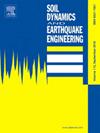Shaking table tests on the seismic response of station structures in deep soil layers under different seismic wave actions
IF 4.2
2区 工程技术
Q1 ENGINEERING, GEOLOGICAL
引用次数: 0
Abstract
This study investigates the liquefaction characteristics of deep soil layers and their subsequent effects on the seismic response of subway station structures, utilizing shaking table tests and inputting seismic waves of varying principal frequencies. Macroscopically, the liquefaction of deep soil strata does not result in surface manifestations such as "water spraying and sand bubbling." However, it still induces cracking and damage to the soil surrounding the structure. Analyzing from the perspective of the "pore pressure ratio" reveals that the ratio under free-field conditions is significantly lower than under structural conditions. Additionally, the "pore pressure ratio" caused by the Beijing Hotel wave is greater, followed by the Beijing artificial wave, while the Ming Shan wave results in the smallest ratio. In terms of the station structure, the structural acceleration and tensile strain increment induced by the Beijing Hotel wave are the most significant, followed by the Beijing artificial wave, with the least effect from the Ming Shan wave. This indicates that the liquefaction behavior of deep soil layers is primarily influenced by the overlying load and the frequency characteristics of seismic waves. The construction of subway stations reduces the overlying loads on soil layers, increasing the likelihood of soil layer liquefaction. Meanwhile, a lower main frequency of the seismic wave results in a higher degree of liquefaction in the deep soil layers. The seismic response of the station structure is contingent on the frequency characteristics of the seismic wave. The lower the primary frequency of the seismic wave, the higher the seismic response of the station structure. Furthermore, the liquefaction behavior of the deep soil layers also impacts the seismic response of the station structure, particularly the tensile strain response of the top and bottom slabs of the station structure.
求助全文
约1分钟内获得全文
求助全文
来源期刊

Soil Dynamics and Earthquake Engineering
工程技术-地球科学综合
CiteScore
7.50
自引率
15.00%
发文量
446
审稿时长
8 months
期刊介绍:
The journal aims to encourage and enhance the role of mechanics and other disciplines as they relate to earthquake engineering by providing opportunities for the publication of the work of applied mathematicians, engineers and other applied scientists involved in solving problems closely related to the field of earthquake engineering and geotechnical earthquake engineering.
Emphasis is placed on new concepts and techniques, but case histories will also be published if they enhance the presentation and understanding of new technical concepts.
 求助内容:
求助内容: 应助结果提醒方式:
应助结果提醒方式:


